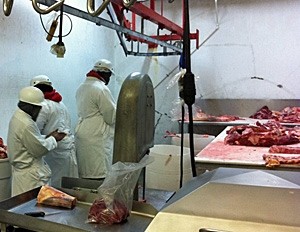Canada was an early adopter of food irradiation, but its status in Canada has remained unchanged for almost 50 years. This article explores reasons for maintenance of the status quo and offers a glimpse of how irradiation can be strategically used to improve the safety of food and the health of Canadians.
 If government food safety initiatives and oversight are risk- and science-based in Canada, it is difficult to understand how the current impasse in appraising the application for extended use of food irradiation has occurred. On July 16, 2013, Health Canada granted “expedited status” for the evaluation of a petition from the Canadian Cattleman’s Association (CCA) to use low dose ionizing irradiation to eliminate E. coli O157:H7 from beef.
If government food safety initiatives and oversight are risk- and science-based in Canada, it is difficult to understand how the current impasse in appraising the application for extended use of food irradiation has occurred. On July 16, 2013, Health Canada granted “expedited status” for the evaluation of a petition from the Canadian Cattleman’s Association (CCA) to use low dose ionizing irradiation to eliminate E. coli O157:H7 from beef.
There has been no meaningful progress to date, and no apparent political will to change that. While the Consumer’s Association of Canada supports adoption of the proposal and is impatient with the lack of progress, Health Canada is reluctant to move forward because of a history of activist opposition to the extended use of food irradiation to other foods1 beyond its permitted use at 0.75 kilogray (kGy) for onions and potatoes, 1.5 kGy for grain and flour, and 10 kGy for spices and dried seasonings. During debates in 1986 and again in 2002 when an initiative for expanded use of food irradiation became a legislative proposal in Canada Gazette Part I, focused opposition led by activists halted its adoption.1 While the CCA petition seems to have been temporarily swept under the rug and although it is hard to determine its status because of regulatory opacity, it appears that there will be little regulatory action until food irradiation is proven harmless to activists. It is uncertain how activists might differ physiologically from the normal consumer; however, it is clear that most are poorly qualified to design, conduct or evaluate scientific work examining the effects of this process on food (Note that issues associated with psychology and psychiatry are beyond the scope of this article).
The scientific basis for the toxicological safety and nutritional adequacy of food irradiated at doses of ≤ 10 kGy has been firmly established as a result of the most extensive body of international research ever accumulated for any food process.2 Doses sufficient for sterilization of food with unaltered sensory characteristics (≤ 60 kGy) were similarly considered acceptable3 and have been used to prepare food for NASA (and Canadian) astronauts for > 40 years. Both Health Canada4 and the CFIA5 have taken positions in support of the use of irradiation to improve the safety of food, but do not permit its use for that purpose in Canada. The safety of irradiated foods has been endorsed by the United States (U.S.) Centers for Disease Control (CDC), the U.S. Department of Agriculture, the U.S. Food and Drug Administration, and is approved for some food use in over 55 countries. Further, the CDC states that “food irradiation is a logical next step to reducing the burden of foodborne disease in the United States”. 6
The greatest potential value from the use of ionizing irradiation to enhance food safety is by treatment of uncooked foods of animal origin, particularly poultry, where “good food” is naturally, unavoidably and consistently contaminated with Campylobacter, Salmonella and toxigenic E. coli (beef), in spite of the best application of good hygienic practices and sanitation in abattoirs and packing plants. With the proliferation of “zero tolerance” rules in North America for pathogens in uncooked foods, the escalating waste and unnecessary cost of recalled animal and plant-based foods because they are not pathogen-free, the use of irradiation becomes an attractive solution. It is ironic that delayed adoption in Canada of expanded animal and plant- based food irradiation and adoption of “zero tolerance” rules have both been driven by “consumer” pressure, which has been fostered by perceived risk to the regulators themselves from the consequences of making either a science-based or politically expedient decision in response to the petition.
The next most strategic target for application of irradiation to improve the safety of food is animal feed. It is folly to ignore the contribution recycling of zoonotic pathogens by feed at both traditional small and large production facilities makes to contamination of human food. It must be remembered that it is within the gastrointestinal tract of healthy domestic animals where pathogens that most frequently cause foodborne illness are resident, multiply and are shed in large numbers from asymptomatic hosts. Irradiation of animal feed would be proactive and complementary to its treatment of food by preventing animal colonization by pathogens, reducing exposure of carcasses to pathogens at slaughter and reducing pathogen contamination of produce by inadequately composted, contaminated manure. Composting can effectively eliminate pathogens from manure but attaining lethal temperatures during the process is unpredictable and almost impossible in most places in Canada during winter. Dependable disinfection of produce cannot currently be achieved by any single treatment (even irradiation) and therefore prevention of contamination is the best, but seldom achieved, option for its safety when used uncooked as human food.
Food irradiation is not a panacea to eliminate foodborne illness but it can reduce its incidence by a substantial proportion and some estimates suggest by 25% if used for poultry, which is the single commodity responsible for most cases of foodborne illness in Canada7 and deaths from foodborne illness in the U.S.8 There are physico-chemical and sensory limits determining which foods can be successfully irradiated to improve safety. At doses effective for controlling bacterial pathogens many dairy products develop “off” flavours and odours caused by lipid oxidation, the whites of treated shell eggs become opaque and less viscous, shellfish (oysters, clams and mussels) die, yielding no advantage, and embryos in treated seeds become non-viable. Except for viruses which are resistant and prions, where the lethal target nuclear material is absent, pathogens can be controlled in most foods at doses ≤ 5 kGy, but if food is frozen or dried higher doses are required. In the U.S., spices and dried herbal seasonings may be irradiated at ≤ 30 kGy for sterilization.6 Although contamination of grains and peanuts by mycotoxigenic fungi can be controlled by irradiation treatment at 5-6 kGy, doses of ≥ 10 kGy are needed to substantially reduce mycotoxin levels in grains.9 Seeds for sprouting may be treated up to 8 kGy6, but in order to maintain the minimum commercial seed germination rate of 95%, lower doses are more practical. In fact, Sikin et al.10 suggested that of all alternatives, including 20,000 ppm chlorine, to ensure the microbial safety of sprouted seeds (a recalcitrant cause of foodborne illness outbreaks), a 50 to 60oC treatment of seeds to be germinated followed by ≤ 2.5 kGy irradiation treatment of the sprouts (mung, radish, broccoli, alfalfa and soy) was the most effective and preserved functional and sensory properties. However, given the small size of individual sprout production operations and their wide geographic distribution, it is unlikely this industry could afford access to irradiation facilities. Fresh produce is increasingly becoming a major contributor to foodborne illness outbreaks, and unlike in Canada where poultry is the leading cause of foodborne illness, leafy green vegetables are the food commodity responsible for causing most illness in the U.S.8 Commercial treatments currently available for disinfecting produce are only marginally effective and irradiation is a viable alternative. Because fresh produce quality is reduced at treatments > 1 kGy, a 220 ppm chlorine wash plus irradiation at 1 kGy11 or a 1 kGy treatment in high oxygen atmospheres12 were the most effective means to assure elimination of both surface and internal pathogen contamination of produce.
Although it is not strictly a food safety application, phytosanitary use of irradiation to control invasive, quarantine insect pests on imported fruits and vegetables has, since 1995, been used on a continuous basis in the U.S. and internationally for mangoes, papaya and a variety of similar products. In Canada, irradiation for insect disinfestation is only permitted for wheat flours and grain at ≤ 1.5 kGy, but for fruits and vegetables lower levels of 0.15 to 0.4 kGy are used commercially with success.13 Because irradiation replaces the use of hot water immersion, heated air and methyl bromide fumigation, which are partly effective or undesirably toxic, the recent growth in phytosanitary use of irradiation can be expected to continue.
A technical problem associated with the more popular use of e-beam irradiation in the U.S. to avoid radioactive waste disposal problems and bad press accompanying use of radioactive isotopes (γ-ray sources) is its low penetrability. Even with double-sided or dual-pass exposures, the thickness of the e-beam target is limited to ≤ 10 cm and this makes it impossible to uniformly treat pallet-sized stacks of packaged food. Although there are also technical and cost issues that need to be overcome, machine generated x-rays are likely to become popular internationally for food irradiation because they have high penetrability, produce no hazardous waste, and the beam generated travels in more controllable parallel lines, rather than dispersed as with γ-rays.13
The claim by activists (Public Citizen) echoed by others (Sierra Club, Food and Water Watch, and the European Civil Society) that irradiation is a “cheap fix” for industry is not borne out by reality. With uncooked foods of animal and plant origin there is no suitable fix available other than irradiation to address “zero tolerance”. In terms of phytosanitary irradiation where alternatives are available for some types of produce to control quarantine insects, they are less expensive than irradiation. Costs of irradiation depend on the dose (type of source) required, proximity to an irradiation facility and throughput. They can range from $0.03 to $1.97/kg ($ U.S.) but can be moderated by efficiencies of scale.13
The formation of compounds (2-alkylcyclobutanones) believed to be uniquely radiolytic in origin and toxic was an objection raised by activists to food irradiation that received attention in earlier discussion. It now appears that they also occur in non-irradiated food14 and may not be acceptable indicators to detect irradiated food, but more importantly this observation minimizes the argument that irradiation does strange things to food. As with any new idea and theory, time is on the side of robust science and eventually will be vindicated.
Objections to the irradiation of food invariably include a call for further whole food (WF) toxicity studies in animals to establish the safety of the process. To date over 30 lifetime WF studies have been conducted involving thousands of animals yielding no measureable effect on safety, yet results were often ambiguous because the studies did not have the sensitivity to identify specific effects of the irradiation treatment. At dietary levels of irradiated components sufficient to test for irradiation effects (chemical changes are so small), an unbalanced diet must be fed, which confounds the outcome.15 With the sophistication and sensitivity of the analytical chemistry technology used today to test for radiolytic products as well as changes in nutrients, unambiguous results are possible and confirm both the nutritional adequacy and toxicological safety of irradiated food, and that further WF toxicity testing is unnecessary.
Summary
While the experimental evidence is very clear that irradiation of food does not produce compositional changes that are of toxicological significance to humans, the controversy continues, fuelled by activists with agenda filled with suspicion of the food industry and regulatory agencies, while “good food” causes 11,000 Canadians to become ill each day16, 2013), and kill an unrecorded number as a result of bacterial pathogens controllable by irradiation. Although I am reluctant to go as far as Farkas and Mohácsi-Farkas2 who suggested that those who provide misinformation about food irradiation are guilty of a form of “terrorism” because they contribute to delayed adoption of a technology that could prevent significant morbidity and mortality, I am disappointed that the evidence to date in Canada shows that the responsible regulatory authority appears reluctant to use available science as the basis for rule making.
References
[1] Gauthier, E. (2010). Social representations of risk in the food irradiation debate in Canada, 1986-2002. Sci. Communication, 32: 295. Available at: http://scx.sagepub.com/content/32/3/295 Accessed Sept. 19, 2014.
[2] Farkas, J. & Mohácsi-Farkas, C. (2011). Trends Food Sci. Technol. 22:121.
[3] WHO (1999). Joint FAO/IAEA/WHO Study Group. High-dose irradiation: wholesomeness of food irradiated with doses above 10 kGy. World Health Organization Technical Report Series 890, Geneva: Available at:
http://apps.who.int/iris/handle/10665/42203#sthash.xI0bA6J5.dpuf Accessed Sept. 23, 2014.
[4] Health Canada (2013). Food irradiation: proposed regulatory changes-archived. Available at: http://www.hc-sc.gc.ca/fn-an/securit/irridation/rlo_pres-eng.php Accessed Sept 23, 2014.
[5] CFIA (2014). Canadian Food Inspection Agency. Food irradiation. Available at: http://www.inspection.gc.ca/food/information-for-consumers/fact-sheets/irradiation/eng/ Accessed Sept 23, 2014.
[6] CDC (2014). Centers for Disease Control, USA. Irradiation of food. Available at: http://www.cdc.gov/nczved/divisions/dfbmd/diseases/irradiation_food/ Accessed Sept 23, 2014.
[7] Ravel, A. et al. (2009). J. Food Protect. 72:1963.
[8] Painter, J.A. et al. (2013). Emerg. Infect. Dis. 19:407.
[9] Calado, T. et al. (2014). Comp. Rev. Food Sci. Food Safety, 13:1049.
[10] Sikin, A. M. et al. (2013). J. Food Protect. 76:2099.
[11] Puerta-Gomez, A.F. et al. (2013). Food Control, 31:410.
[12] Olaimat, A.N. & Holley, R.A. (2012). Food Microbiol. 32: 1-19.
[13] Hallman, G.J. (2011). Comp. Rev. Food Sci. Food Safety, 10:143.
[14] Crews, C. et al. (2012). J. Food Comp. Anal. 26:1.
[15] Bartholomaeus, A. et al. (2013). Crit. Rev. Toxicol. 43:1.
[16] Thomas, M.K. et al. (2013). Food. Path. Dis. 10:639.
Department of Food Science,
University of Manitoba, Winnipeg, Manitoba, R3T 2N2
(*Corresponding author email: rick_holley@umanitoba.ca)











